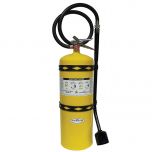 In Australia, Class D fire extinguishers are used on combustible metals, such as magnesium, titanium, sodium, etc., which require an extinguishing medium that does not react with the burning metal. Here’s a guide on how to identify them, how they work and when to use them safely:
In Australia, Class D fire extinguishers are used on combustible metals, such as magnesium, titanium, sodium, etc., which require an extinguishing medium that does not react with the burning metal. Here’s a guide on how to identify them, how they work and when to use them safely:
Class D fire extinguisher colour:
Our Class D fire extinguisher has a yellow body and has a light LIGHT GREY colour band wrapped around the top of its cylinder.
Class D fire extinguisher sizes:
Available in 2 portable Sizes: 13.5L & 18L.
How does a Class D extinguisher work?
Each type of extinguisher works by attempting to remove one of the elements that are needed for a fire to flourish. Class D Extinguishers contain a a special blended Sodium Chloride-based dry powder extinguishing agent (B570), this solution smothers the fire and removes the element of heat. Heat from the fire causes it to cake and form a crust excluding air and dissipating heat from burning metal. C571 contains a copper extinguishing agent.
When to use a Class D extinguisher?
Class D Fire extinguishers are only used on class D fires (Flammable metals).
Class D Extinguishers:
Class D Fires - magnesium, sodium, potassium, sodium-potassium alloys, zirconium, uranium, titanium, and powdered aluminum, lithium and lithium alloy.

Class D extinguisher DO NOT USE ON:
Class D extinguishers should not be used on fires involving flammable materials, electrical equipment, flammable gases, cooking oil and fats, and also are not suitable for use on flammable liquids. They are also Not recommended for lithium-ion battery fires.
Where to use a Class D extinguisher?
Class D extinguishers can be used indoors and outdoors.
How to use a Class D Fire Extinguisher?
Knowing how to operate a Class D fire extinguisher could save your life in an emergency.
The key to putting out a metal fire with a Class D extinguisher is to use the PASS strategy: Pull the pin, Aim the hose towards the base of the fire, Squeeze the lever, and Sweep the hose.
Remember: Fires double in size every 60 seconds so use a fire extinguisher for small, contained fires only. Leave immediately if you're unable to extinguish the fire and call 000.
Class D extinguisher Service & Maintenance:
In an Australian business environment, all Class D extinguishers must undergo a recharge and hydrostatic testing every 5 years. All Class D fire extinguishers must carry a maintenance tag that shows their last inspection date, and must be serviced every 6 months. Once your extinguisher has been discharged, it must be pressure tested & recharged, or replaced.
They should not be installed in locations directly exposed to extreme cold (possibility of freezing in conditions lower than -5°C).
At home, Class D extinguishers can last up to 10 years but you need to check them regularly (we recommend twice a year to check the following: pressure is at the recommended level, nozzle or hose are not obstructed, pin and tamper seal is intact, no dents, leaks, rust, chemical deposits and other signs of wear).
How to clean up after a Class D fire extinguisher?
- Protective gear - Sodium Chloride-based dry powder is known to be irritating (eyes, mucous membranes, or skin), it’s best to put on goggles and impermeable protective gloves before starting.
- Soak – soaking up the residue using paper towels or something disposable that can soak up the residue.
- Wash – Use water to wash the affected area until completely clean and continue to soak up any left over residue.
- Throw – Once clean, take the dirty towels and seal them in a plastic bag. You can then throw the contents away as you would any normal waste.
Class D fire extinguisher discharge effects to be aware of:
- Sodium Chloride health effects and symptoms – Moderate irritant to the respiratory system and eyes; mild irritant to the skin. In case of contact rinse immediately with water, and consult medical attention if any symptoms persist.
- Prohibited disposal in drain systems – Class D extinguishers are not safe to discharge down normal drains;
How to Refill & Recharge a Class D fire extinguisher:
In Australia, Class D Fire extinguishers must be discharged and recharged every 12 months. The refill process should be done by a trained professional (handling of pressurized chemicals). If it is not done adequately, the extinguisher could malfunction in case of an emergency.
Here are simplified steps of the Class D refill process:
- Empty and depressurize the extinguisher (remove hose, valve assembly, clean...)
- Fill the cylinder with the amount of chemical specified on the label
- Re-Pressurize the extinguisher (check for leaks)
- Reconnect hose and ring pin
- Weigh the fully assembled fire extinguisher
Class D fire extinguisher Disposal & Recycling:
Class D Fire extinguishers are classified as a dangerous good and can not be disposed of at your household waste collection and/or curb-side collection. So how do you safely dispose of a used, expired but unused or empty carbon dioxide fire extinguisher?
Please check this article to dispose or recycle your old Class D Fire Extinguisher: https://www.fireextinguisheronline.com.au/fire-extinguisher-recycling
You can also contact your local fire department and enquire if you can drop those off at the firehouse to dispose of them (only for expired but full or partially filled fire extinguishers). And you can contact your local council.


